Which Mineral Is Commonly Found In Igneous Rocks? Olivine is the mineral that is commonly found in igneous rocks and at rockscapes.net, you can explore how this mineral contributes to the beauty and diversity of rock formations and garden landscapes. This article explores the common minerals found in igneous rocks, detailing their formation, characteristics, and significance in landscape design. Learn how mineral composition influences the aesthetic and structural properties of rocks, and how this knowledge enhances outdoor spaces.
1. What Minerals Are Igneous Rocks Made Of?
Igneous rocks are mainly made of silicate minerals because silicon and oxygen are very common in magmas. So, silicate minerals are key in these rocks. Knowing which minerals are in igneous rocks helps us understand how they formed and what makes each rock unique. Igneous rocks are found all over the world. These rocks have different minerals depending on where they are from and how they cooled.
2. What Are the Key Concepts Related to Igneous Rocks and Silicate Minerals?
Key concepts related to igneous rocks and silicate minerals include:
- Igneous minerals are created as magma cools and crystallizes into igneous rocks.
- The many different types of magma have varying compositions, giving rise to many different kinds of rocks containing different minerals.
- Crystal size and rock texture are affected by the rate at which the rock cools.
- Minerals crystallize in a predictable, orderly fashion as magma cools.
- Silicates form the base of many igneous rocks.
- The arrangement and ordering of SiO4 tetrahedra within silicates are used to classify them.
- Distinctive characteristics, atomic arrangements, and origins can be found in different silicate minerals.
These ideas help to fully understand how igneous rocks form, what they are composed of, and how they are classified.
3. Where Do Magmas and Igneous Rocks Originate?
Magmas, which are molten rocks, are the source of igneous rocks and minerals. They are located beneath Earth’s surface. Magma can accumulate in huge magma chambers far beneath the Earth’s surface, yet it is also mobile and can move through fissures, sometimes even reaching the surface. The majority of magmas can be found close to or at the Earth’s surface in subduction zones and mid-ocean ridges. The remaining portion is made up of continental rifts and hot spots, which are regions where unusually high heat rises from great depths.
 Magma forms igneous rocks and minerals beneath the Earth’s surface
Magma forms igneous rocks and minerals beneath the Earth’s surface
4. How Does Cooling Rate Affect Igneous Rock Texture?
Grain size in an igneous rock is directly correlated with cooling rate. Granite, a typical plutonic rock, has quartz and potassium feldspar crystals that are easily visible to the naked eye. Quartz appears gray, while feldspar has a salmon hue in the granite shown below (Figure 6.4). Although rhyolite (Figure 6.5), a typical volcanic rock, may contain the same minerals, a microscope is required to see the crystals. Because it contains minute crystals of pink potassium feldspar, the rhyolite in Figure 6.5 is pink. Additionally, it has bigger quartz crystals that appear as black spots in the rock. Crystals in granites have a long time to grow and may get fairly large. In contrast, volcanic rocks like rhyolite crystallize swiftly because eruption exposes the erupting magma to the cool atmosphere of the Earth’s surface. As a result, any crystals that do form are minute.
4.1 What Are Aphanitic, Phaneritic, and Porphyritic Textures?
Plutonic rocks that have cooled rapidly may be very fine-grained, making them difficult to distinguish from volcanic rocks. As a result, some petrologists prefer to classify and name igneous rocks based on their grain size rather than their genesis (origin). They divide rocks into those containing very fine grains (aphanitic), rocks containing very coarse grains (phaneritic), and rocks containing combinations of large and small crystals (porphyritic).
5. Where Can Igneous Rocks Be Found?
Igneous rocks that have been extruded can be found all over the world, and specific types are not restricted to a single tectonic setting. Basalt is the igneous rock that is the most prevalent in the Earth’s crust. Basalt is created at mid-ocean ridges, which make up the majority of the uppermost oceanic crust, as the oceans cover two-thirds of the Earth. Ocean basalt is typically found in layers that are 1/2 kilometer thick and may or may not be covered by sediments. These basalts occasionally take the form of pillow basalts, like the one in this image (Figure 6.7). The pillow structure develops when basalt is pushed into frigid ocean water.
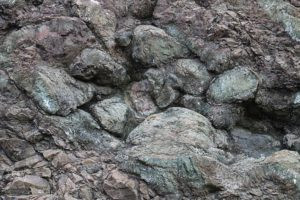 Pillow basalt often forms in layers covered by sediments
Pillow basalt often forms in layers covered by sediments
6. What Is the Significance of Silica Content in Igneous Rocks?
Although all igneous rocks are composed of the same major elements, the ratios of those elements can change. The amount of silica (SiO2) present is the most noticeable difference (see table). Silica makes up between 45 and 70 weight percent of most igneous rocks. They range from basalt and gabbro, which have lower silica content, to rhyolite and granite, which have higher silica content. Other elemental concentrations fluctuate in a predictable manner as well. For instance, basalt and gabbro have more iron and magnesium than andesite and diorite, whereas andesite and diorite have more iron and magnesium than rhyolite and granite. Other compositional differences are either less significant or less consistent.
7. What is Bowen’s Reaction Series?
N. L. Bowen pioneered in the study of magma crystallization, for which he received the Roebling Medal from the Mineralogical Society of America in 1950. By studying naturally occurring igneous rocks and conducting laboratory experiments, he derived an idealized model for equilibrium crystallization in a magmatic system. We call the model Bowen’s reaction series; it is depicted below in Figure 6.17. Although Bowen’s series is a generalization that does not apply in detail to all magma types, it is an excellent model to describe the process of crystallization. Some petrologists have developed more precise models for magmas of specific compositions.
 Bowen’s reaction series shows the order in which minerals crystallize from magma
Bowen’s reaction series shows the order in which minerals crystallize from magma
8. What Are the Different Types of Silicate Structures?
Silicate minerals are classified based on the arrangement of silica tetrahedra:
8.1 Isolated Tetrahedra
These silicates, like olivine, have independent tetrahedra linked only by cations.
8.2 Single Chain Silicates
In pyroxenes, tetrahedra form zigzag chains.
8.3 Double Chain Silicates
Amphiboles feature two chains of tetrahedra linked together.
8.4 Sheet Silicates
Micas and clays consist of tetrahedra arranged in sheets.
8.5 Framework Silicates
Feldspars and quartz have a three-dimensional network where every oxygen is shared.
9. What Role Does Quartz Play in Igneous Rocks?
Quartz is an essential mineral in silicic and intermediate igneous rocks, many sediments, and many metamorphic rocks. Quartz is not normally found in mafic igneous rocks because crystallization of mafic minerals such as olivine or pyroxene generally consumes all silica that is available, so there is none left over to form quartz.
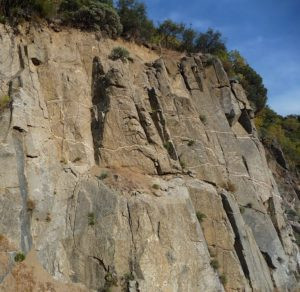 Granites contain essential quartz minerals
Granites contain essential quartz minerals
10. Why are Feldspars the Most Abundant Minerals in Earth’s Crust?
Feldspars are the most abundant minerals in Earth’s crust, in part because they contain six of the seven most abundant elements in the crust. They are widespread and are essential minerals in many igneous, metamorphic, and sedimentary rocks. Feldspars are solid-solution minerals and have the general formula (Ca,Na,K)(Si,Al)4O8. Rarely, they contain significant amounts of other elements such as Ba, Sr, B, or Fe.
 Feldspars contain six of the seven most abundant elements in the crust
Feldspars contain six of the seven most abundant elements in the crust
10.1 What Are Plagioclase and Alkali Feldspars?
Natural feldspars form two distinct series, the alkali feldspar series and plagioclase. Alkali feldspar, mainly solutions of orthoclase and albite, sometimes contains up to 15 wt % anorthite. Plagioclase, often called plagioclase feldspar, is mostly a solid solution of albite and anorthite, although it may contain up to 10 wt % orthoclase. We call any feldspar with composition near NaAlSi3O8, albite, and one with composition near CaAl2Si2O8, anorthite, even if other components are present.
11. What Are Feldspathoids?
The feldspathoid minerals are framework silicates similar to feldspars in many of their properties. They are, however, much less common. Feldspathoids are a family of about a dozen minerals; they are all Na-, K-, and Ca-aluminosilicates. The family is not like other mineral groups, whose members are related by similar atomic arrangements and chemistries. Instead these minerals are grouped together because of their relationship to feldspars.
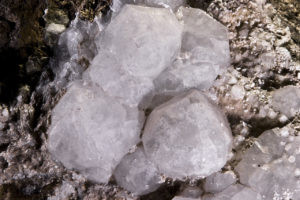 Feldspathoids like analcime are similar to feldspars
Feldspathoids like analcime are similar to feldspars
12. What Role Do Micas Play in Igneous Rocks?
Micas have the general formula XY2-3Z4O10(OH)2. Some specific formulas are given in the blue box above. The X atoms are most often K and, less commonly Na or Ca, or rarer elements. If the X atom is K or Na, we call the mica a common mica, if it is Ca (e.g., in margarite), we call the mica a brittle mica. Y atoms are generally Al, Mg, or Fe, and less often Mn, Cr, Ti, or Li. Z atoms are mostly Si, with lesser amounts of Al, and even lesser amounts of Fe or Ti.
 Micas such as muscovite, biotite and phlogopite play a key role in igneous rocks
Micas such as muscovite, biotite and phlogopite play a key role in igneous rocks
13. What are the Most Common Pyroxenes?
Pyroxenes contain many different elements, but all pyroxenes have the general formula shown in the blue box. The most common pyroxenes are close to Ca(Mg,Fe)Si2O6 or (Mg,Fe)2Si2O6 in composition. So, we can describe the chemistries of most pyroxenes in terms of the five end members listed in the box. The formulas for wollastonite, ferrosilite and enstatite have been written with six oxygen, but they could be written with three. We generally use six to keep formulas consistent with other pyroxenes such as diopside and hedenbergite and also because Ca, Fe, and Mg occupy two distinctly different atomic sites in pyroxenes. Distinguishing the different pyroxene species can be challenging. In the absence of a chemical analysis, black colored pyroxenes are often called augite.
 The most common pyroxenes are close to Ca(Mg,Fe)Si2O6 or (Mg,Fe)2Si2O6
The most common pyroxenes are close to Ca(Mg,Fe)Si2O6 or (Mg,Fe)2Si2O6
14. What Are Amphiboles and How Do They Relate to Pyroxenes?
Amphiboles and pyroxenes are closely related minerals that commonly coexist. Both are chain silicates, but the atomic arrangement in amphiboles is more complex than in pyroxenes. Like pyroxenes, amphibole chemistry is highly variable and yields many different end member formulas.
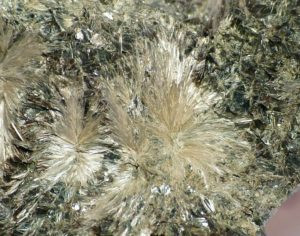 Amphiboles like hornblende are closely related to pyroxenes
Amphiboles like hornblende are closely related to pyroxenes
15. What Are Ring Silicates and Paired Tetrahedral Silicates?
Ring silicates, generally containing rings of six silicon tetrahedra (see Figure 6.24), are relatively rare. Beryl, tourmaline and cordierite are the only common examples.
Paired tetrahedral silicates contain linked pairs of silicon tetrahedra that create an Si2O7 group (see Figure 6.24 earlier in this chapter). Epidote, zoisite, and lawsonite are the most common examples.
 Epidote and tourmaline are examples of paired tetrahedral and ring silicates
Epidote and tourmaline are examples of paired tetrahedral and ring silicates
16. What Is the Composition and Significance of Olivine Group Minerals?
Olivine group minerals, belonging to the isolated tetrahedra silicate subclass, all have similar atomic arrangements. By far, the most important mineral of this group is called olivine. In contrast with some of the other silicates previously discussed, olivine chemistry is quite simple. Its general formula is (Mg,Fe,Ca,Mn)2SiO4 but often we omit Mn and Ca because they are normally minor components. The most important end members are listed in the blue box.
 Green olivine phenocrysts and vesicles in basalt.
Green olivine phenocrysts and vesicles in basalt.
Olivine occurs predominantly in mafic and ultramafic igneous rocks. Its very mafic composition restricts its occurrence, and other mafic minerals containing the same elements with additional silicon are more abundant. In some basalts Mg-rich olivine forms large green phenocrysts in a fine-grained plagioclase-pyroxene groundmass. Mg-rich olivine is never found in felsic rocks, but Fe-rich olivine is occasionally found in some granites. Olivine occurs in some metamorphic rocks, including marble and metamorphosed igneous rocks. Olivine also is found in mantle xenoliths – samples of the mantle that have been carried to the surface by magmas.
17. How Are Igneous Rocks Classified and Named?
There are a number of different ways to divide igneous rocks into groups and to give them names. Assigning names can be complicated because igneous rocks vary greatly in mineralogy and texture, and because rock types grade from one to another. It is somewhat simplified because, with rare exceptions, the major elements in all igneous rocks are the same.
17.1 What is the IUGS System?
Most igneous rocks contain feldspar or quartz. So, the most widely used and relatively straightforward classification scheme for igneous rocks is based on the relative amounts of quartz, plagioclase, and alkali feldspar that are present. It is the International Union of Geological Sciences (IUGS) system. Using this system, only the ratios of quartz, plagioclase, and alkali feldspar determine the rock name.
17.2 What is the TAS System?
Volcanic rocks may be very fine grained, making mineral identification difficult or impossible, and they may contain significant amounts of volcanic glass in lieu of minerals. So, instead of naming volcanic rocks based on mineralogy, petrologists often assign names based on alkali and silica content. This is the total-alkali-silica system (TAS). The diagonal red line divides rocks into those that we call alkalic (above the line) and sub-alkalic (below the line). The most common volcanic rocks are sub-alkalic, ranging in composition from basalt (mafic) to rhyolite (silicic).
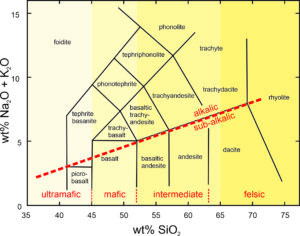 The TAS system divides volcanic rocks into alkalic and sub-alkalic
The TAS system divides volcanic rocks into alkalic and sub-alkalic
18. What Role Do Silicate Minerals Play in Determining Rock Types?
The table below lists the silicate minerals just considered. Quartz, at the very top of the table, has an Si:O ratio of 1:2. The ratio decreases downward in the table, and olivine, at the bottom of the list, has an Si:O ratio of 1:4. This reflects the fact that quartz is a felsic mineral and olivine is a mafic mineral.
The left hand column in this table lists the silicate subclass, and the right hand column shows the ratio Si:O, or (Si,Al):O in a formula. So, the ratio tells us whether a silicate mineral is a framework, sheet, double chain, etc. All double chain silicates, for example, contain (Si,Al)8O22 in their formulas. Paired tetrahedral silicates contain Si2O7 in their formulas.

19. How Do Accessory Minerals Contribute to Igneous Rocks?
This chapter focused on silicates, but igneous rocks often contain other minerals. The most common are listed in the table seen here. Most exist as accessory minerals because they are composed of rare elements or of elements that easily fit into other minerals.
20. What Defines Silicic Igneous Rocks?
Silicic igneous rocks include the plutonic rocks granite, granodiorite, and tonalite, and their volcanic equivalents (rhyolite, dacite, quartz andesite). All contain > 20% quartz and we name them based on the amounts of K-feldspar and plagioclase they present.
21. What Defines Mafic and Intermediate Igneous Rocks?
Mafic rocks contain less that 5% quartz, if any. A dark color, due to an abundance of hornblende, clinopyroxene, or olivine, and sometimes Ca-rich plagioclase, characterizes these rocks. Intermediate igneous rocks are those in which quartz accounts for 5% to 20% of the rock.
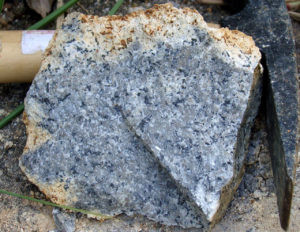 Mafic and Intermediate igneous rocks range in composition and color
Mafic and Intermediate igneous rocks range in composition and color
22. What Defines Ultramafic Igneous Rocks?
Ultramafic rocks are especially poor in SiO2 and have high Mg:Fe ratios. Pyroxene (either orthopyroxene or clinopyroxene), olivine, and (less commonly) plagioclase are the dominant minerals in these rocks. The IUGS system names ultramafic rocks based on their relative amounts of olivine, orthopyroxene, and clinopyroxene.
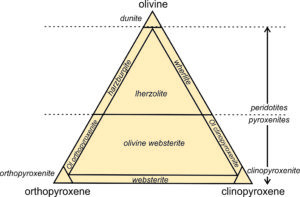 Ultramafic rocks are poor in SiO2 and have high Mg:Fe ratios
Ultramafic rocks are poor in SiO2 and have high Mg:Fe ratios
By exploring the minerals commonly found in igneous rocks, particularly the role of olivine, we gain a deeper appreciation for the diverse and dynamic nature of Earth’s geology. Understanding how these minerals form and contribute to different rock types enriches our knowledge of landscape design and the natural beauty of our planet.
Ready to explore the possibilities of incorporating igneous rocks into your landscape? Visit rockscapes.net today to discover stunning design ideas, learn about various rock types, and consult with our experts to bring your vision to life. Transform your outdoor space with the timeless elegance and durability of natural stone!
Address: 1151 S Forest Ave, Tempe, AZ 85281, United States
Phone: +1 (480) 965-9011
Website: rockscapes.net
Frequently Asked Questions (FAQ)
23. What is the most abundant mineral in igneous rocks?
Feldspar is the most abundant mineral in igneous rocks. This group of minerals makes up a significant portion of the Earth’s crust.
24. Which igneous rock is known for its large crystals?
Pegmatite is known for its large crystals, often containing rare minerals. The large crystal size is due to the presence of water, which acts as a flux.
25. What mineral gives basalt its dark color?
The dark color of basalt is primarily due to the presence of minerals like pyroxene and olivine, which are rich in iron and magnesium.
26. Can you find diamonds in igneous rocks?
Diamonds are primarily found in kimberlites and lamproites, which are types of ultramafic igneous rocks that originate deep within the Earth.
27. What is the difference between granite and rhyolite?
Granite is a plutonic (intrusive) igneous rock that cools slowly beneath the Earth’s surface, resulting in large crystals. Rhyolite is a volcanic (extrusive) igneous rock that cools quickly on the Earth’s surface, resulting in small crystals.
28. Are all igneous rocks hard?
Igneous rocks are generally hard due to their interlocking crystalline structure. However, the exact hardness can vary based on mineral composition and density.
29. What is the process of magma crystallization?
Magma crystallization is the process by which minerals form as magma cools. Different minerals crystallize at different temperatures, following Bowen’s Reaction Series.
30. How does weathering affect igneous rocks?
Weathering can break down igneous rocks through physical and chemical processes. Physical weathering involves the disintegration of rocks, while chemical weathering involves the alteration of minerals.
31. What are some common uses of igneous rocks?
Igneous rocks are used in construction for buildings, roads, and monuments. They are also used for landscaping and decorative purposes.
32. Why are some igneous rocks porphyritic?
Porphyritic textures occur when there are two distinct crystal sizes in an igneous rock. This indicates that the magma cooled at two different rates: slowly at depth to form large crystals (phenocrysts) and then rapidly at the surface to form the fine-grained groundmass.